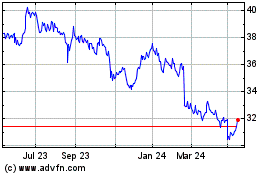Woolworths and Lowe's Exit Home-Improvement Venture
January 18 2016 - 7:57AM
Dow Jones News
By Rebecca Thurlow
SYDNEY--Australian retailer Woolworths Ltd. and U.S. partner
Lowe's Cos. are exiting their unprofitable home-improvement store
venture, which has struggled to take market share from rival
Bunnings.
Woolworths said Monday that it plans to buy Lowe's 33.3% stake
and then either sell or liquidate the business, which includes more
than 50 warehouse-style stores across Australia.
Woolworths and Lowe's have plowed roughly three billion
Australian dollars (US$2 billion) into the Masters Home Improvement
chain since 2011, hoping to capitalize on a booming housing market
that has spurred spending on home projects.
The chain has struggled to compete against Bunnings, owned by
Australian conglomerate Wesfarmers Ltd., missing its target of
breaking even within five years. Masters reported a full-year loss
of A$246 million for fiscal 2015.
"Our recent review of operating performance indicates it will
take many years for Masters to become profitable," Woolworths
Chairman Gordon Cairns said. "We have determined we cannot continue
to sustain ongoing losses from this business."
Lowe's Australian exit comes as it is benefiting from higher
home values in the U.S. and more people moving into new homes. The
company reported a third-quarter profit of $736 million, a 26%
increase from a year earlier.
Lowe's expects to record a noncash impairment charge in the
fourth quarter for exiting the Woolworths venture. The company's
investment to date in the venture was $930 million.
Australia, with its relatively small population of around 23
million, spread out over a huge continent, struggles to sustain a
large number of major players in any industry.
Woolworths, which makes most of its profits from grocery stores,
came to the A$40 billion home-improvement market late, making it
difficult to compete with Bunnings, which opened its first store 20
years ago and now has more than 236 stores.
"We believe the big-box [warehouse] format can only attain
around 15% of the market and Bunnings already has that," said
Commonwealth Bank of Australia analyst Andrew McLennan, adding that
the business opportunity was "smaller than Woolworths
anticipated."
In an industry made up mostly of smaller operators, Masters
aggressively rolled out new stores before making sure customers
wanted to buy what it was offering, Mr. McLennan said. That
included a decision to align its products with Lowe's U.S. hardware
stores--meaning it was selling products and brands unfamiliar to
most Australians.
Wesfarmers on Monday announced plans to expand its hardware
business offshore, in a A$705 million deal to buy U.K.-based
Homebase and build the Bunnings brand there.
Woolworths said it would prefer a trade sale of the Masters
business but hadn't yet received any approaches from interested
parties, leaving the possibility of large write-downs if the
business is liquidated. Still, investors appeared pleased at the
prospect of being freed from the struggling business, sending
Woolworths' shares up 5% in midday trading in Sydney.
Mr. McLennan said Woolworths may sell individual stores to
buyers such as Bunnings or Costco Wholesale Corp.
"But for the A$3 billion that's been sunk into the business
they'll probably get very little out of it," Mr. McLennan said.
Write to Rebecca Thurlow at rebecca.thurlow@wsj.com
(END) Dow Jones Newswires
January 18, 2016 07:42 ET (12:42 GMT)
Copyright (c) 2016 Dow Jones & Company, Inc.
Woolworths (ASX:WOW)
Historical Stock Chart
From Oct 2024 to Nov 2024

Woolworths (ASX:WOW)
Historical Stock Chart
From Nov 2023 to Nov 2024
